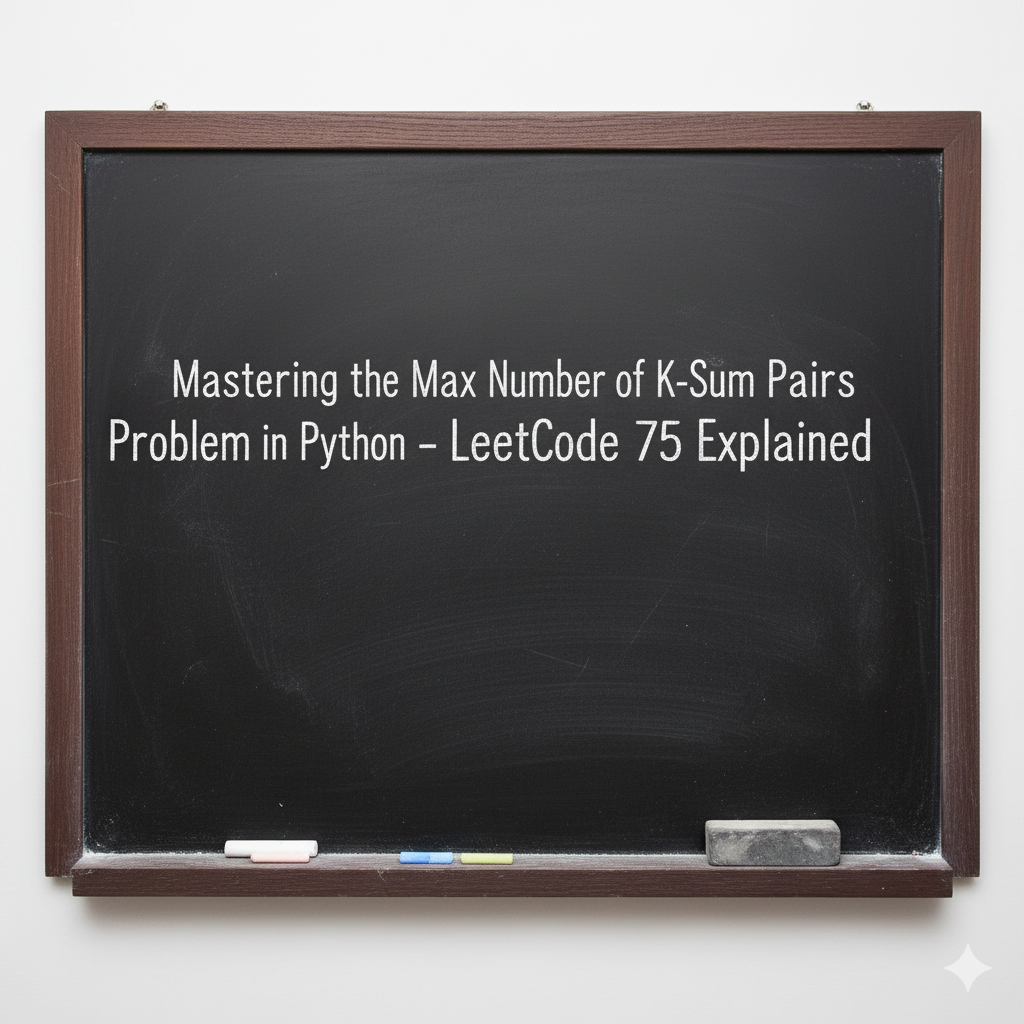The Max Number of K-Sum Pairs problem from LeetCode 75 is a common interview question that tests your understanding of sorting, two-pointer techniques, and pair sum calculations. The challenge is simple to describe: given an array of numbers and a target sum k, determine the maximum number of pairs whose sum equals k. However, solving it efficiently for large arrays requires a smart approach.

Table of Contents
In this blog post, we’ll break down the problem, present a clean Python solution, and explain why it’s optimal for interviews and real-world applications.
Problem Statement
Given an integer array nums and an integer k, return the maximum number of operations you can perform on the array to form pairs whose sum equals k. Each element can be used at most once.
Understanding the Problem
The key idea is to form pairs (nums[i], nums[j]) such that nums[i] + nums[j] = k. Each number can only belong to one pair, so we need to be careful about counting.
Examples
Example 1:
Input: nums = [1,2,3,4], k = 5
Output: 2
Explanation: Pairs are (1,4) and (2,3)
Example 2:
Input: nums = [3,1,3,4,3], k = 6
Output: 1
Explanation: Only one pair sums to 6, e.g., (3,3)
Python Solution – Step-by-Step Explanation
Here’s a clean Python solution using the two-pointer technique:
class Solution:
def maxOperations(self, nums: List[int], k: int) -> int:
nums.sort()
if not nums:
return 0
start, end, result = 0, len(nums) - 1, 0
while start < end:
sum_pair = nums[start] + nums[end]
if sum_pair < k:
start += 1
elif sum_pair > k:
end -= 1
else:
start += 1
end -= 1
result += 1
return result
Step 1: Sort the Array
nums.sort()
- Sorting helps efficiently check sums from both ends.
- The smallest number is at
startand the largest atend.
Step 2: Initialize Two Pointers
start, end = 0, len(nums) - 1
result = 0
startpoints to the smallest element.endpoints to the largest element.resultkeeps track of valid pairs found.
Step 3: Traverse and Count Pairs
while start < end:
sum_pair = nums[start] + nums[end]
if sum_pair < k:
start += 1
elif sum_pair > k:
end -= 1
else:
start += 1
end -= 1
result += 1
- If the sum is less than
k, movestartforward to increase the sum. - If the sum is greater than
k, moveendbackward to decrease the sum. - If the sum equals
k, a pair is found: incrementresultand move both pointers.
Step 4: Return Maximum Pairs
return result
- After the pointers cross,
resultcontains the maximum number of valid pairs.
Why This Solution Works
- Uses a two-pointer strategy to efficiently scan the sorted array.
- Ensures that each element is used at most once.
- Avoids nested loops, giving a linear time complexity after sorting.
Time and Space Complexity
| Metric | Value |
|---|---|
| Time Complexity | O(n log n) – due to sorting |
| Space Complexity | O(1) – only pointers and counters |
Edge Cases to Consider
| Case | Output | Explanation |
|---|---|---|
| nums = [] | 0 | No pairs exist |
| nums = [1,1], k = 2 | 1 | One valid pair |
| nums = [1,2,3], k = 7 | 0 | No valid pair |
| nums = [3,3,3,3], k = 6 | 2 | Handles duplicates correctly |
Real-World Applications
- Transaction matching: Pairing purchases and refunds efficiently.
- Resource allocation: Grouping items to meet target constraints.
- Interview prep: Tests understanding of greedy strategies and two-pointer techniques.
Conclusion
The Max Number of K-Sum Pairs problem is a classic example of how sorting combined with two-pointer techniques leads to efficient solutions. By carefully moving pointers and counting pairs, you can achieve optimal performance even on large arrays.
Mastering this problem not only strengthens your problem-solving skills for array-based challenges but also provides a strong foundation for tackling more complex pairing and summation problems in coding interviews and real-world tasks.
Related Reads
- PyTorch Cheatsheet: The Ultimate Quick Reference for Beginners and Developers
- The Ultimate TensorFlow Cheatsheet: From Basics to Advanced
- Applied Machine Learning – CS 5785 at Cornell Tech: Complete Course Guide
- NLP Text Preprocessing Cheatsheet 2025: The Ultimate Powerful Guide
- Plotly Cheatsheet 2025: Powerful Techniques from Beginner to Advanced
External Links
🔗 LeetCode Problem Page – Max Number of K-Sum Pairs

5 thoughts on “Mastering the Max Number of K-Sum Pairs Problem in Python – LeetCode 75 Explained”